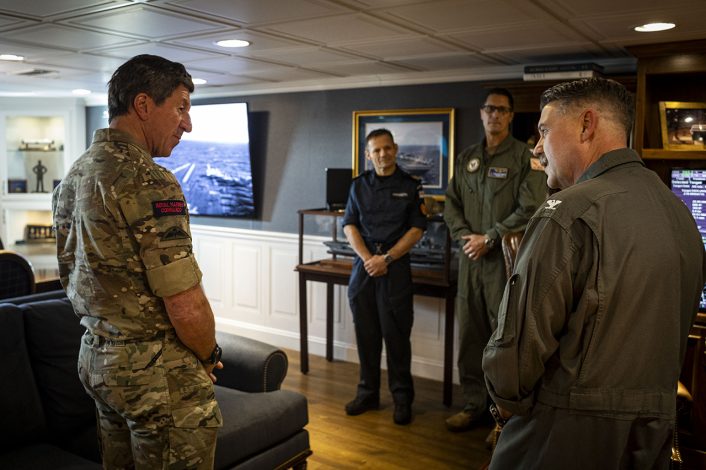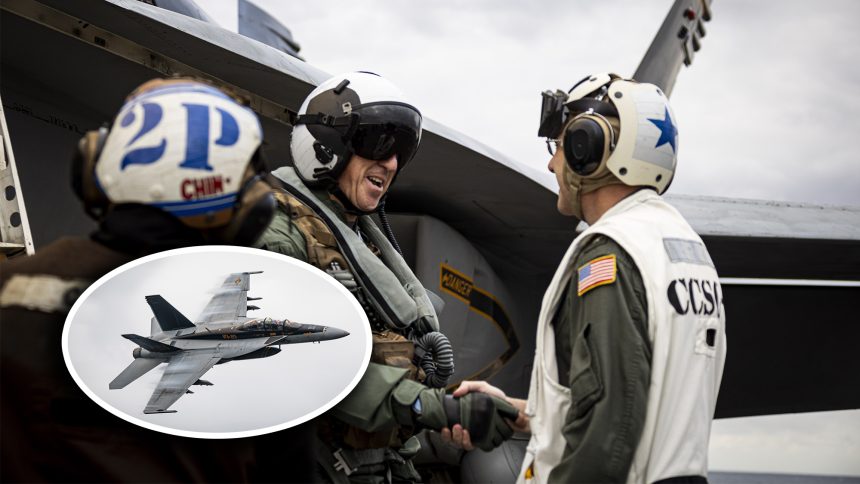General Sir Gwyn Jenkins, First Sea Lord of the Royal Navy, visited the U.S. Navy aircraft carrier as it operated in the North Sea, complete with a backseat ride in an F/A-18F Super Hornet.
In his first visit to a U.S. Navy aircraft carrier since being appointed as First Sea Lord, the professional head of the Royal Navy, General Sir Gwyn Jenkins toured the world’s largest warship as it sailed in the North Sea following a high profile visit to Oslo. The USS Gerald R. Ford (CVN 78) is leading Carrier Strike Group 12 (CSG-12) on a deployment to the U.S. Sixth Fleet, having departed Norfolk Naval Base in Virginia on June 24, 2025.
Jenkins, who is the first ever First Sea Lord to be promoted from the ranks of the Royal Marines, met with Rear Admiral Paul Lanzilotta, commander of CSG-12, and commanding officer of USS Gerald R. Ford Captain David Skarosi while on board the ship. He also spoke to members of the ships’ crew and personnel from the embarked Carrier Air Wing 8 (CVW-8). The arguable highlight of the visit saw the British General ‘suit-up’ with Strike Fighter Squadron 213 (VFA-213) ‘The Blacklions’ and take to the rear seat of one of the squadron’s F/A-18F Super Hornet strike fighters for a flight sortie, including catapult launch and an arrested recovery.

In addition to U.S. personnel, the First Sea Lord also took the opportunity to meet and speak to members of the Royal Navy who are currently serving as CVW-8 pilots through international exchange programs. Royal Navy and Royal Air Force pilots are a near constant presence in both U.S. Navy/Marine Corps and U.S. Air Force aircraft squadrons, and in fact the commanding officers of both of the UK’s frontline F-35B Lightning II units are veterans of such exchange programs. 809 Naval Air Squadron boss Commander Nick Smith formerly flew F/A-18E Super Hornets, while 617 Squadron commanding officer Lieutenant Colonel Mike Carty flew U.S. Marine Corps AV-8B Harrier IIs during Operation Inherent Resolve.

The Ford has taken part in a number of exercises since its arrival into the European theater. An initial operating period in the Mediterranean saw the Ford take part in Neptune Strike 25-2 – described by NATO as a vigilance activity – and launch aircraft on simulated strike sorties across Europe. A port visit was undertaken in Marseille, France.
On 24 and 25 July, 🇺🇸 U.S. Navy F/A-18 Super Hornet fighter jets, launched from the aircraft carrier USS Gerald R Ford sailing in the Mediterranean, conducted long-range strike missions to 🇱🇹 Lithuania as part of NATO’s enhanced Vigilance Activity Neptune Strike 25-2 (NEST).
The… pic.twitter.com/ePAuSUYocZ
— NATO Allied Joint Force Command Brunssum – JFCBS (@NATOJFCBS) July 26, 2025
After departing the Mediterranean Sea, the carrier strike group transited to the high north, taking part in more NATO training programs with local forces, including the next iteration of Neptune Strike, Neptune Strike 25-3.
In the North Sea, USS Gerald R. Ford (CVN 78) demonstrates the strength of NATO during Neptune Strike 25-3.
Together, we protect vital waters 🌊 and strengthen the bonds that keep us secure 💪. pic.twitter.com/DFmkMBizZt
— U.S. Fleet Forces (@USFleetForces) September 26, 2025
Sailing alongside the Ford are U.S. Navy destroyers USS Bainbridge (DDG 96), USS Mahan (DDG 72), and the USS Winston S. Churchill (DDG 81). The Winston S. Churchill paid a visit to HMNB Portsmouth, UK, while passing through the English Channel, with Royal Navy officer Lieutenant Commander Owen Long acting as navigator. In honor of the ship’s namesake a Royal Navy officer is always seconded to the ship’s crew, and the ship is also granted the right to fly the Royal Navy’s white ensign.
An RN navigation officer is always assigned to serve onboard 🇺🇸USS Winston S Churchill.
Lt Cdr Owen Long guided the ship into Portsmouth when she arrived on Sunday. The destroyer has recently been operating in the Arctic as part of the USS Gerald R Ford carrier strike group.… pic.twitter.com/dvJxlMLBkZ
— Navy Lookout (@NavyLookout) September 17, 2025
General Sir Gwyn Jenkins
Gen. Jenkins’ career history in the Royal Marines didn’t include any time as a pilot, though the 35-year veteran has spent well over a decade in high-level positions. From 2009, Jenkins commanded the Special Boat Service (SBS) – one of the UK’s premier special forces units. By 2012, he moved to the position of Military Assistant to the Prime Minister, then on to Deputy National Security Advisor in 2016.
Between 2021 and 2022, Jenkins oversaw all UK special forces operations as Director Special Forces. In 2022, after a promotion to the rank of General – becoming only the second full General in the Royal Marines in almost 50 years – he became Vice-Chief of the Defence Staff and Commandant General of the Royal Marines. Jenkins succeeded Vice Admiral Sir Martin Connell as First Sea Lord on May 27, 2025, Connell having in turn taken on the position in an acting capacity to replace Admiral Sir Ben Key 20 days earlier.
Since his appointment, Jenkins has endorsed a radical evolution of the Royal Navy, stating his aim to see the next Carrier Strike Group deployment to the Indo-Pacific (scheduled for 2029) supported by operational unmanned combat aircraft and unmanned surface vessels. In his speech at DSEI 2025, he confirmed that plans were afoot to see a jet-powered collaborative combat aircraft launch from Royal Navy aircraft carrier HMS Queen Elizabeth by the end of 2026.
As a member of the Royal Marines, particular focus will be paid to Jenkins’ influence on the future of the Royal Navy’s amphibious capabilities, which have been gutted by the loss of the Albion class but could see a strong refresh with the introduction of Multi-Role Strike Ships (MRSS) in the 2030s. Orders for MRSS have yet to be placed, and will need to be placed during Jenkins’ expected tenure should the Royal Navy have any hope of replacing its once powerful amphibious force any time soon. Critically, Royal Navy amphibious ships have long been intended to provide an important backstop to reinforce parts of Europe in the event of Russian offensives.









